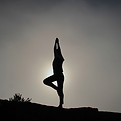

the path of
STRETCHING
THE STRETCHING PATH
The stretching path is an enlightening journey that delves into the art and science of improving flexibility, enhancing physical health, and promoting mental well-being. At its core, this path revolves around the practice of stretching - a fundamental yet often overlooked aspect of overall fitness and health. Stretching is not just a series of physical movements to loosen up the muscles; it's a holistic discipline that intertwines the nurturing of the body with the tranquillity of the mind.
Embarking on the stretching path means exploring various techniques and forms, from dynamic stretches that warm up the body for activity, to static stretches that are held for a period to increase flexibility and range of motion. This journey isn't limited to athletes or fitness enthusiasts; it's a path for anyone seeking to enhance their body's functionality, reduce the risk of injury, and improve posture.
The stretching path is also deeply intertwined with mental relaxation and stress reduction. The practice encourages mindfulness and focused breathing, which not only aids in the effectiveness of the stretches but also helps calm the mind, reduce anxiety, and enhance mental clarity.
Moreover, regular stretching can be a powerful tool in combating the stiffness and aches associated with sedentary lifestyles, especially for those who spend long hours at desks or in front of screens. It offers a moment of active rest, a chance to reconnect with the body and listen to its needs.
In essence, the stretching path is about cultivating a harmonious balance between the body and mind. It's a journey that leads to greater physical freedom, mental serenity, and an overall sense of well-being, making it an essential and rewarding practice in the pursuit of health and vitality.

WHY STRETCH
Walking the stretching path is immensely beneficial, offering a wide array of advantages for both physical and mental well-being. One of the primary reasons to embrace this path is the improvement it brings to physical health. Regular stretching enhances flexibility, which is crucial for the overall functionality of the body. It increases the range of motion in joints, reduces the risk of injuries, and improves posture. Enhanced flexibility also means better physical performance in daily activities and sports, making movements more fluid and less energy-consuming.
Moreover, stretching plays a key role in alleviating and preventing the stiffness and pain often associated with sedentary lifestyles and aging. By regularly elongating the muscles, stretching helps to relieve muscle tension and can alleviate common issues such as back pain and neck stiffness.
On the mental health front, the stretching path offers significant benefits. The practice of stretching, especially when combined with mindful breathing, can be a form of meditation in motion, helping to calm the mind and reduce stress. It provides a mental break, allowing for a moment of tranquility amidst a busy lifestyle. This relaxation effect is not only mentally soothing but also contributes to better sleep quality and improved concentration.
Furthermore, engaging in regular stretching routines encourages discipline and mindfulness, traits that are beneficial beyond physical health. It instils a sense of routine and self-care, emphasising the importance of taking time to nurture both body and mind.
The stretching path is more than just a series of physical exercises; it's a holistic approach to health that integrates the physical benefits of improved flexibility and reduced discomfort with the mental benefits of stress relief and enhanced focus. It's a path that leads to a more balanced, relaxed, and healthy life.

If you don't stretch now, you'll regret it later in life.
HOW TO STRETCH
Embarking on the stretching path involves incorporating a series of practices and habits that focus on enhancing flexibility, physical well-being, and mental clarity. Here’s how you can effectively walk this path:
Establish a Routine
Consistency is key in any stretching regimen. Set aside a specific time each day for your stretching routine. This could be in the morning to energise your body, during a break to alleviate stiffness, or in the evening to relax your muscles before bed.
Learn Proper Techniques
To get the most out of stretching and avoid injury, it’s important to learn the correct techniques. This might involve taking classes, watching instructional videos, or working with a fitness professional. Understanding how to stretch correctly ensures that you’re targeting the right muscles without straining.
Incorporate Different Types of Stretching
Include a variety of stretches in your routine. Dynamic stretches are great as a warm-up to prepare your muscles for physical activity, while static stretches, where you hold a position for a period, are excellent for increasing flexibility and cooling down after exercise.
Focus on Whole-Body Flexibility
Ensure your stretching routine addresses all major muscle groups. This holistic approach helps maintain a balanced body and prevents overcompensation injuries.
Listen to Your Body
Pay attention to how your body feels during each stretch. Stretching should never cause pain. If you feel any discomfort, ease up on the intensity or try a different position.
Combine Stretching with Mindful Breathing
To enhance the mental benefits of stretching, combine it with mindful breathing. This practice helps in releasing tension not just from the body but also from the mind.
Progress Gradually
Like any physical practice, progress in stretching comes over time. Gradually increase the intensity and duration of your stretches as your flexibility improves.
Walking the stretching path is about making a commitment to your physical and mental health. It’s a practice that requires patience and persistence, but the rewards in terms of flexibility, reduced stress, and overall well-being are immense.

The more flexible your body, the stronger it has the potential to be. You open new ranges of motion and like an elastic band, a muscle that can be stretched further can harness more power and energy.
MOBILITY
Mobility, often intertwined with stretching, is a crucial aspect of overall fitness and wellness, deserving equal attention on the journey to physical well-being. While stretching primarily focuses on the muscles, mobility exercises target the range of motion in the joints and the activation of the muscles surrounding them. Here’s why mobility is an essential companion to stretching and how it contributes to a holistic approach to physical health:
Enhances Joint Health
Mobility exercises help maintain and improve the range of motion in your joints, which is crucial for performing daily activities and physical exercises efficiently and safely. Good joint mobility reduces the risk of injuries and ensures that the joints are well-lubricated and healthy.
Improves Functional Movement
Mobility training goes beyond static poses and involves dynamic movements that mimic everyday activities or specific sports movements. This training helps in performing these activities with greater ease and less risk of injury, making it particularly important for athletes and individuals with active lifestyles.
Complements Stretching
While stretching elongates the muscles, mobility exercises ensure that the movement in the joints is optimised. Together, they contribute to a more comprehensive and balanced approach to physical fitness, addressing both muscular and joint health.
Reduces Pain and Stiffness
Regular mobility exercises can alleviate pain and stiffness, particularly in areas prone to tightness like the hips, shoulders, and back. This is particularly beneficial for individuals who experience joint stiffness or those who sit for extended periods.
Improves Posture and Body Awareness
Mobility training enhances body awareness, helping you to understand how your body moves and how to correct poor postural habits. Improved posture not only looks better but also reduces strain on your body, especially in the neck and back.
Incorporating mobility exercises alongside stretching into your fitness routine ensures a well-rounded approach to your body’s functionality. It’s about creating a harmonious balance between flexibility and the functional range of motion, leading to improved physical performance, reduced risk of injury, and enhanced overall well-being.
BENEFITS

Regular stretching improves flexibility, which is essential for your overall health. Enhanced flexibility reduces the risk of injuries and improves your ability to perform daily activities with ease.

Consistent stretching helps increase your range of motion, making it easier and more comfortable to move your joints.

Stretching the muscles of the lower back, shoulders, and chest can help keep your back in better alignment and improve posture.

Stretching increases blood flow to the muscles, which can lead to increased nutrient supply and improved circulation throughout the body.

Stretching exercises can help to relieve stress by relaxing tense muscles that often accompany stress. The act of stretching also encourages a focus on mindfulness and relaxation.

Flexible muscles are less likely to become injured from a slightly extensive movement. By increasing the range of motion in a particular joint through stretching, you can decrease the resistance on your muscles during various activities.
Walks
"Fasted Flow" combines intermittent fasting with exercise, yoga or stretching, creating a lighter, more agile body. This path enhances focus and vitality, fostering a deeper connection between body and mind. Both journeys offer essential tools for personal growth and transformation.
Change happens through movement, and movement heals.
Joseph Pilates
Stretching is not just about making muscles longer; it's about changing the brain's tolerance to a new range of motion.
Thomas Myers
"The body is your temple. Keep it pure and clean for the soul to reside in."
B.K.S. Iyengar

